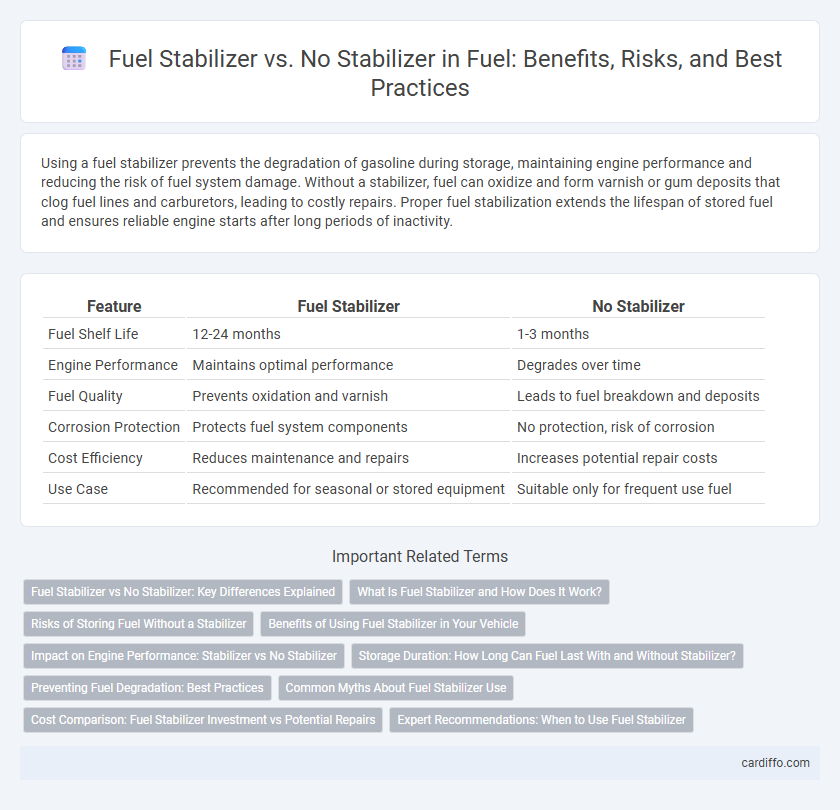Using a fuel stabilizer prevents the degradation of gasoline during storage, maintaining engine performance and reducing the risk of fuel system damage. Without a stabilizer, fuel can oxidize and form varnish or gum deposits that clog fuel lines and carburetors, leading to costly repairs. Proper fuel stabilization extends the lifespan of stored fuel and ensures reliable engine starts after long periods of inactivity.
Table of Comparison
| Feature | Fuel Stabilizer | No Stabilizer |
|---|---|---|
| Fuel Shelf Life | 12-24 months | 1-3 months |
| Engine Performance | Maintains optimal performance | Degrades over time |
| Fuel Quality | Prevents oxidation and varnish | Leads to fuel breakdown and deposits |
| Corrosion Protection | Protects fuel system components | No protection, risk of corrosion |
| Cost Efficiency | Reduces maintenance and repairs | Increases potential repair costs |
| Use Case | Recommended for seasonal or stored equipment | Suitable only for frequent use fuel |
Fuel Stabilizer vs No Stabilizer: Key Differences Explained
Fuel stabilizer prevents oxidation and the formation of gum and varnish in fuel, extending its shelf life significantly compared to untreated fuel. Without stabilizer, fuel degrades faster due to exposure to air and moisture, leading to poor engine performance and potential damage. Using fuel stabilizer ensures consistent combustion efficiency and reduces costly repairs associated with stale fuel.
What Is Fuel Stabilizer and How Does It Work?
Fuel stabilizer is a chemical additive designed to prevent fuel degradation during storage by inhibiting oxidation and evaporation. It works by forming a protective layer that slows the breakdown of gasoline, preserving its quality and preventing varnish, gum, and gum deposits in engines. Without stabilizer, stored fuel can oxidize and deteriorate within weeks, leading to engine performance issues and costly repairs.
Risks of Storing Fuel Without a Stabilizer
Storing fuel without a stabilizer increases the risk of oxidation and fuel degradation, leading to the formation of varnish and gum deposits that clog fuel systems. Ethanol-blended fuels absorb moisture over time, causing phase separation that can damage engines and reduce fuel efficiency. Prolonged storage without stabilizers accelerates corrosion in fuel tanks and injectors, resulting in costly repairs and equipment downtime.
Benefits of Using Fuel Stabilizer in Your Vehicle
Using a fuel stabilizer prevents the oxidation and gum formation that can degrade gasoline over time, ensuring cleaner fuel combustion and improved engine performance. It extends the life of stored fuel by maintaining its chemical integrity, reducing the risk of engine starting problems and costly repairs caused by stale fuel. Regular use of fuel stabilizers also protects fuel systems from corrosion, enhancing overall vehicle reliability and longevity.
Impact on Engine Performance: Stabilizer vs No Stabilizer
Using a fuel stabilizer prevents fuel degradation by maintaining chemical integrity, which ensures consistent combustion and optimal engine performance. Engines without a stabilizer often experience fuel oxidation and varnish buildup, leading to clogged fuel injectors, poor acceleration, and increased emissions. Stabilized fuel enhances engine reliability, reduces maintenance costs, and extends the lifespan of fuel system components.
Storage Duration: How Long Can Fuel Last With and Without Stabilizer?
Fuel treated with stabilizer can remain usable for up to 12-24 months by preventing oxidation and degradation, significantly extending storage life. Without stabilizer, gasoline typically degrades within 1-3 months, leading to gum formation and engine performance issues. Diesel fuel without additives may last 6-12 months, but stabilizers can prolong usability beyond a year by maintaining fuel quality and preventing microbial growth.
Preventing Fuel Degradation: Best Practices
Fuel stabilizers significantly slow the oxidation process that leads to fuel degradation, preserving fuel quality during extended storage. Without a stabilizer, gasoline can break down within 30 days, forming varnish and gum deposits that clog carburetors and fuel lines. Best practices include adding fuel stabilizer before storage, keeping tanks full to minimize air exposure, and storing fuel in cool, sealed containers to prevent moisture contamination and maintain engine performance.
Common Myths About Fuel Stabilizer Use
Fuel stabilizers prevent oxidation and varnish buildup in gasoline, yet many myths claim their use is unnecessary for short-term storage. Contrary to belief, gasoline degrades within 30 days without stabilizer, leading to engine starts issues and costly repairs. Proper use of fuel stabilizer extends fuel life up to 12 months, preserving engine performance and reducing maintenance expenses.
Cost Comparison: Fuel Stabilizer Investment vs Potential Repairs
Fuel stabilizers typically cost between $5 and $15 per treatment, offering an affordable preventative measure against fuel degradation. Without stabilizer use, fuel systems can incur repair costs ranging from $200 to over $1,000 due to issues like clogged carburetors or damaged fuel injectors. Investing in a fuel stabilizer significantly reduces the risk of costly repairs, providing economical long-term savings by maintaining fuel quality and engine performance.
Expert Recommendations: When to Use Fuel Stabilizer
Experts recommend using fuel stabilizer primarily for engines or vehicles that will be stored for more than 30 days to prevent fuel degradation and varnish buildup. Without stabilizer, gasoline oxidizes and forms gums that can clog fuel systems, leading to costly repairs and decreased performance. For short-term use or frequently operated engines, stabilizers are generally unnecessary, but prolonged storage demands their use to maintain fuel quality and engine reliability.
Fuel Stabilizer vs No Stabilizer Infographic

 cardiffo.com
cardiffo.com